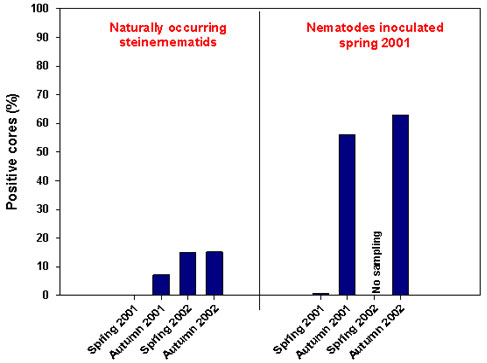Subproject 2 Entomopathogenic nematodes
Participants
Otto Nielsen and Holger Philipsen, Institute of Ecology, Royal Veterinay and Agricultural University, Copenhagen.
Email: Otto.Nielsen@ecol.kvl.dk
Background
Entomopathogenic nematodes are soil living organisms. In order to fulfil their life cycle they infect insects living in the soil. The insects are killed and serve as a food source for the nematodes. Entomopathogenic nematodes are commercially produced and are used for biological control in mushroom production, glass houses and high value crops outdoor.
Objectives
The main objective is to study the influence of cultural practise on the abundance of entomopathogenic nematodes. Further, the effect of the nematodes on selected pest insects and beneficial insects are studied.
Activities and results
The experiments are carried out in the organic cropping system at Årslev and in selected main crops and catch crops at the KVL experimental station (Snubbekorsgård). In the laboratory, ground beetles are exposed to entomopathogenic nematodes to test the susceptibility of these beneficial insects. The first experiments revealed that the natural level of entomopathogenic nematodes was low. For that reason, nematodes (Steinernema feltiae) have been inoculated to insure measurable amounts of nematodes. Good establishment of entomopathogenic nematodes has been achieved in relation to pea growing (Figure 1). At Snubbekorsgård, experiments have been carried out with grass, clover and chicory. The nematodes were present in all crops with minor differences between crops (Figure 2). Laboratory experiments with ground beetles showed that these could get infected but mortality was low.
Figure 1. Entomopathogenic nematodes obtained from one of the fields in the organic cropping system at Årslev. The field was grown with pea in 2001 and barley in 2002.

Figure 2. Entomopathogenic nematodes obtained from Snubbekorsgård, KVL. Catch crops were established in 2000 and was the main crop in 2001. In 2002 the whole area was grown with oil seed rape.
Manuscripts in preparation
Otto Nielsen & Holger Philipsen. Population dynamics of entomopathogenic nematodes in an organic cropping system (internationally, reviewed journal)
Otto Nielsen & Holger Philipsen. Susceptibility of ground beetles to entomopathogenic nematodes (internationally, reviewed journal)
Otto Nielsen & Holger Philipsen. Insektpatogene nematoder i økologisk jordbrug - forekomst og betydning for skade- og nyttedyr (Danish journal)
|